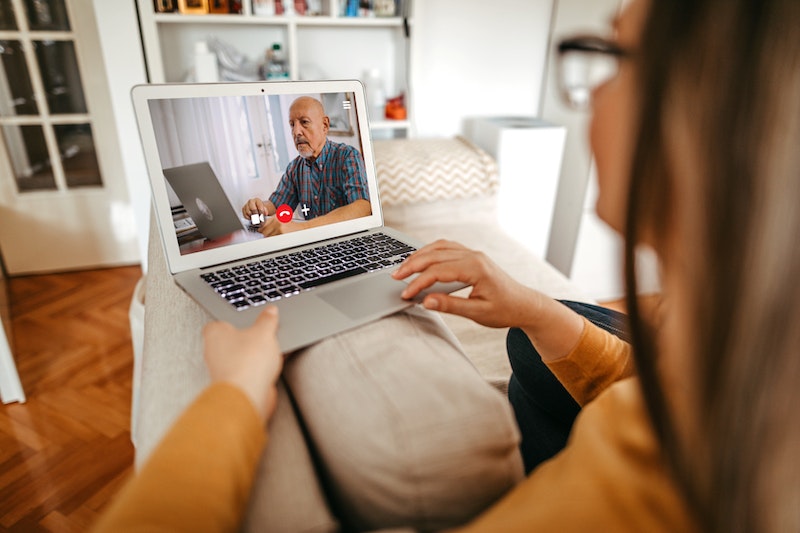These days, our homes are doing double or even triple duty as places not just where we lay our heads, but also as offices, makeshift classrooms, and exercise studios. Now, it seems, with just a little determination and a strong Wi-Fi signal, there’s very little that can’t be accomplished at home. And that includes accessing previously in-person services that have found a new virtual life.
Online therapy — otherwise known as teletherapy — has seen a big boom since the beginning of 2020, and it’s not just digital apps and platforms that are thriving. Most traditional, in-office therapy sessions have gone online. In a May 2020 survey of American Psychiatric Association members, 64% reported that they did not conduct teletherapy sessions at all before the COVID-19 pandemic. Two months into the pandemic, that number shifted dramatically — 85% reported seeing at least three-quarters (if not all) of their patients online.
With government regulations around teletherapy easing, there has never been a better time to speak to a mental health pro online. But if you’ve only ever seen your therapist in person, the transition to online therapy may take some getting used to. However, you can still get a great session virtually. Here’s how.
Preparing for your session
Bring along your creature comforts: With work, school, and extracurriculars all shifting to the home, finding a room where the dog won’t scratch at the door or the kids won’t overhear you may prove challenging. Now’s the time to get creative. What about that downstairs bathroom with the sturdy lock? Or the rarely used attic closet? Or your car sitting in the driveway? They can all serve as therapy pods in a pinch. For added confidentiality, says Christina Aegerter, PsyD, LP, a licensed clinical psychologist in Denver, use headphones so you’re the only one hearing what the therapist is saying, and consider investing in a white noise machine (or using an app on your phone) to heighten privacy and block out distractions if you’re worried about being overheard.
Bring along your creature comforts: “The nice part about being home is you can be comfortable,” says Aegerter. “You can bring your blankets or a well-behaved pet. All those things are welcome as long as they’re used appropriately.” Aegerter adds that you should also have a phone charger, water, and tissues handy.
Set up and test your tech in advance: Arrive at your space a few minutes early to make sure all the necessary apps are loaded and your device is all charged up. “Try and log in a couple minutes early, just so that if you have technical difficulties, you have a little bit of time to get it situated,” says Adrienne Alden, LMFT, PLLC, of Relationship Restoration in Raleigh, NC, who even prior to COVID-19, was experienced at using teletherapy with her clients. She also recommends finding a steady surface for your computer (or if you’re using a phone, placing it on a tripod rather than holding it). “We are getting seasick,” she says of all the wobbly screens therapists have been looking at over the past few months.
Get into focus: Sure, you may not be snapping Glamour Shots, but the lighting in your space matters. “You want the light in front of you, not behind you,” says Aegerter. “Some clients will show up and the window’s behind them, so they're just a blob.” When it comes to the camera’s angle, position it so that your therapist can see your entire body. “A lot of the work is communication and body language,” says Alden.
“If your therapist can only see part of your head, you could be having a panic moment and they might not know it. We can't talk you through it if we can't see it.” To that end, if you’re engaged in a couples’ therapy session, sit next to each other in the same room so your therapist can observe your interactions. Conversely, Alden also recommends hiding the screen display of yourself, whether through an app setting or by placing a sticky note over that part of your screen. “It'd be like doing therapy in front of a mirror,” she says. “People get self-conscious.”
Schedule time to decompress: After spending nearly an hour talking through your feelings and what’s bothering you, you’re not going to feel like jumping into that budget conference call or a big work project five minutes later, Alden says. “I highly recommend that you replicate your drive to and from the session,” says Alden. “The drive to therapy gives you time to shift gears from your daily life to start the introspection process. And then afterwards, you might want to sit quietly to absorb what the session was about and then carry on.”
Evaluating your session
Just as you’re acclimating to teletherapy, so, too, is your therapist. That’s not to say that the session shouldn’t be at the same level of professionalism as it always was. After a few virtual sessions, take some time to reflect on the experience and the quality of your interactions with your therapist online. Aegerter recommends watching out for a few things:
- Your therapist should also be in a private, quiet room where your confidentiality is protected. It’s a good idea for them to be wearing headphones, too.
- They shouldn’t be distracted — or if they know a small distraction is possible (say, a distant dog bark every now and then) they should warn you. But if there are constant knocks at the door or people coming in and out, that may be a problem.
- They should have a good command of the telehealth technology, such as any proprietary software, and be able to talk you through issues.
If you feel like your sessions are lacking in some way, let your therapist know. It’s important to give them feedback to get the most out of your time together.
“I have had a couple of clients specifically on the autism spectrum that really didn't like phone and video — that just did not work for them,” says Aegerter. “So the client let me know that, and when we were allowed to open for in-person again, with precautions, we moved to that.”
If you and your therapist can’t seem to resolve the issue together, it might be time to try a new therapist — from the comfort of your own home.
Articles on Rally Health’s website are provided for informational purposes only, as a free resource for the public. They are not a substitute for medical advice, diagnosis, or treatment. Rally Health does not accept solicitations or compensation from any parties mentioned in the articles, and the articles are not an endorsement of any providers, experts, websites, tools, or financial consultants, services, and organizations.
KATE ROCKWOOD
Rally Health





